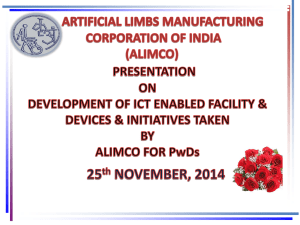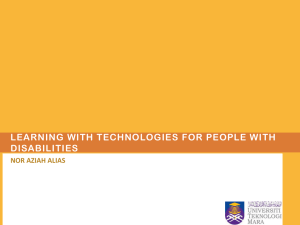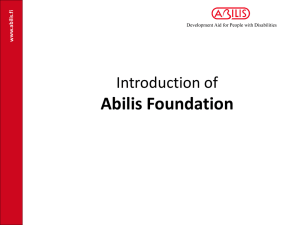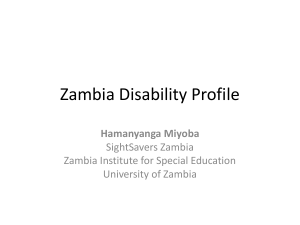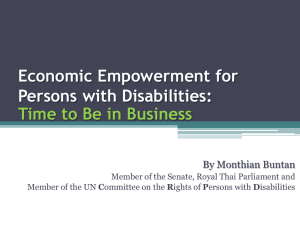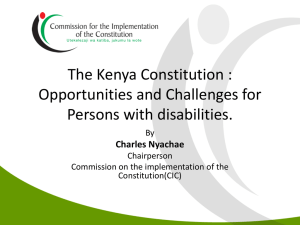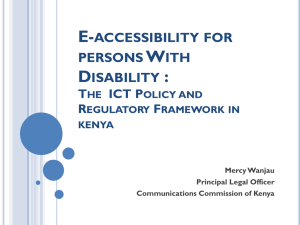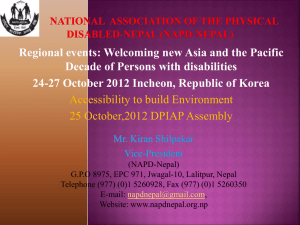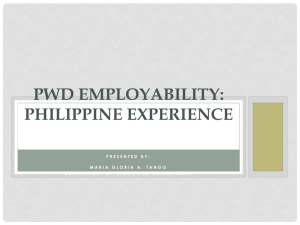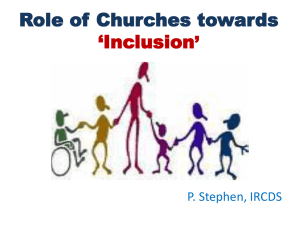rights of persons with disabilities
advertisement
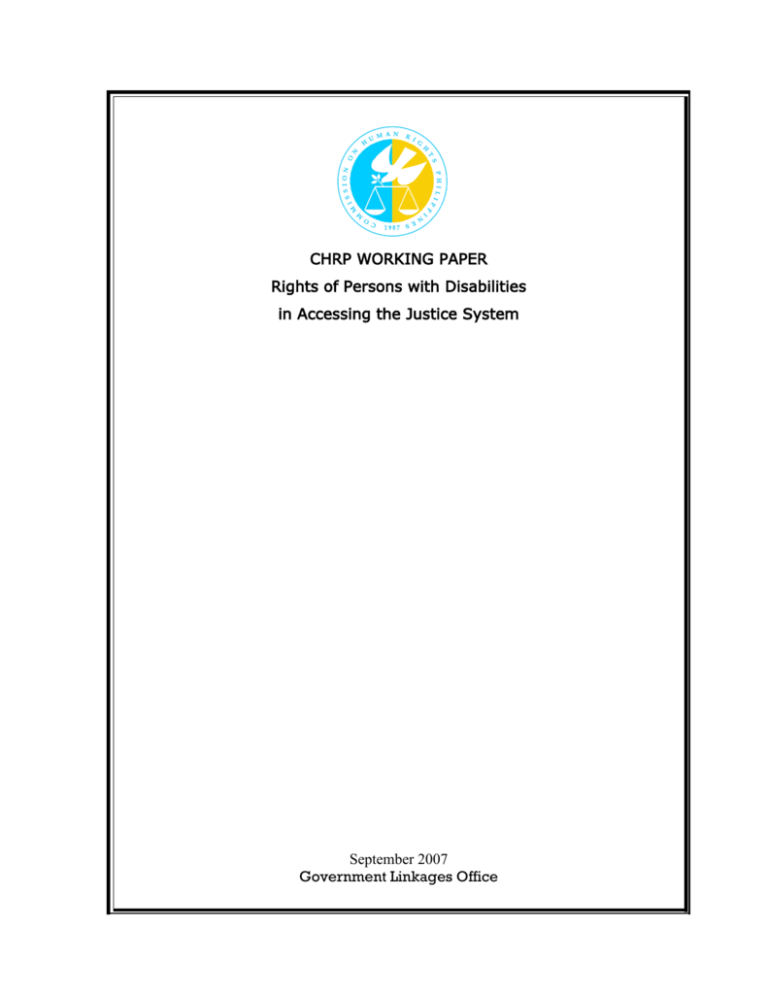
CHRP WORKING PAPER Rights of Persons with Disabilities in Accessing the Justice System September 2007 Government Linkages Office FOREWORD “Full human development … is the optimal development of all that is human in all humans, the bringing to full flower of the native genius of each and of all.” ---words of the greatly admired JOSE W. DIOKNO. More than the advocacy, more than the initiatives, more than the organizations, I was, and still am, greatly amazed and impressed by the vibrance and brilliance of the personalities of co-advocates and acquaintances I have made in the circle of Persons with Disabilities. I said then and I say now, physical impairment can not and should never be made a reason to undermine a person’s capabilities and/or capacities to perform “normally” and even, excellently in his/her own field. When I represented the Commission in the international training programme on Human Rights and Disabilities in Sweden last May 2006, it was my first time to be so involved with PWDs. It was there that I was acquainted with the grim realities of being a PWD. It was there that I saw clearly the barriers faced by people with impairments to achieving equality and justice. It was also there that I strongly felt the need for the integration of disability into the issue of human rights and development. Because disabled people are human beings, it is self-evident that disability is a human rights issue; and it is in the recognition of that intrinsic humanity that we can reach outcomes that would result in the full implementation and protection of their human rights. This project: “SURVEY ON PERSONS WITH DISABILITIES IN ACCESSING THE JUSTICE SYSTEM” is conducted to ascertain that legislative, judicial and administrative measures are in place with respect to the access of PWDs to professionals at all points in the Philippine justice system. 2 This endeavor is likewise a response to the strategic action framework that the Philippine team crafted during the training programme for Human Rights and Disabilities in Sweden. The Commission on Human Rights has taken this initiative in clear recognition of its role as the premier instrumentality in the Philippines in upholding human rights and truly responding to the expectations of the people who are victims of human rights violations; especially those from the vulnerable and disadvantaged sectors like the PWDs. QUINTIN B. CUETO III Commissioner In-Charge for Government Linkages 3 TABLE OF CONTENTS Foreword I. Rights of Persons with Disabilities in Accessing the Justice System 6 II. Monitoring the Rights of Persons with Disabilities 9 III. Complaints Filed with the CHRP Involving Persons with Disabilities, 1987-2006 11 IV. The CHRP as Survey Respondent 14 V. Survey of Government Agencies on their Implementation of the Rights of Persons with Disabilities in Accessing the Justice System 15 VI. Survey of Persons with Disabilities in their Contacts with the Pillars of Justice 20 ANNEXES (not available in PDF) A. Letter to Government Agencies with Survey Questionnaire B. Letter to PWDs with Survey Questionnaire C. Supreme Court Decision: The People of the Philippines, PlaintiffAppellee vs. Marlon Parazo y Francisco, Accused-Appellant D. Pertinent Laws and Issuances on the Welfare of PWDs RA 7277: Magna Carta for Disabled Persons RA 6759: An Act Declaring August One of Each Year as White Cane Safety Day in the Philippines and for Other Purposes BP 344: An Act to Enhance the Mobility of Disabled Persons by Requiring Certain Buildings, Institutions Establishments and Public Utilities to Install Facilities and Other Devices Implementing Rules and Regulations as Amended of BP 344 (Accessibility Law) 4 Proclamation No. 125: Proclaiming the Nationwide Observance in the Philippines of the Asian and Pacific Decade of Disabled persons, 1993-2002 Civil Service Commission Memo Circular No. 23, s. 1999: Employment of Qualified PWDs Rule on Examination of a Child Witness Rule on Juveniles in Conflict with the Law Supreme Court Rulings and Issuances: o A.M. No. 03-05-01-SC: Adopting the New Code of conduct for the Philippine Judiciary (Canon 5) o Benchbook for Trial Court Judges (p 5-8) o Circular No. 46-95: Accessibility of Courtrooms to Disabled Persons o Memorandum Order No. 59-2004: Authorizing the Court Administrator to Act on and Approve Requests of Lower Courts for the Hiring of Sign Language Interpreters o Amended Revised Administrative Circular No. 50-2001: Establishing the Merit Selection and Promotion Plan for the Lower Courts [ IV (1); VI(1)(6)] o Administrative Circular No. 37-2001A: Establishing the Supreme Court Merit Selection and Promotion Plan [ IV (1); VI(1)(b)] Department of Public Works and Highways (DPWH) Internal Memoranda: o Disseminating CSC MC No. 23, s. 1999 relative to the hiring of PWDs o Designating Focal Persons to the Regional Committees for the Welfare of Disabled Persons o Directing All Regional Directors/Project Managers to Implement the Accessibility Law (BP 344) and its Amended Implementing rules and Regulations Commission on Elections: o Resolution No. 6667, 15 March 2004 (Sec. 31) o Resolution No. 2971, 12 January 1998 (Sec. 30) 5 I. RIGHTS OF PERSONS WITH DISABILITIES1 IN ACCESSING THE JUSTICE SYSTEM “Disabled Persons shall be able to avail themselves of qualified legal aid when such aid proves indispensable for the protection of their persons and property. If judicial proceedings are instituted against them the legal procedure applied shall take their physical and mental condition fully into account.” Paragraph 11, Declaration on the Rights of Disabled Persons, Proclaimed by General Assembly resolution 3447 (XXX) of 9 December 1975 People with disabilities include those with intellectual, physical, sensory (hearing, vision, and/or speech), psychiatric/mental illness, or acquired disabilities. People with disabilities are often marginalized and socially excluded. They tend to be older, poorer, less educated and have less employment opportunities than those without disabilities. In countries like Viet Nam, Laos, Cambodia, and Afghanistan, many people are disabled as a direct result of conflict – either as a result of combat wounds or due to landmine explosions. Access to justice for people with disabilities often means overcoming obstacles of discrimination, communication, and physical access. They are at a higher risk of becoming victims of crime and exploitation; they may be unknowingly used by others for criminal purposes; they may be denied opportunities because of their difference; and they may lack access to facilities and resources they need, including courts and other legal institutions. Discrimination and Exclusion People with disabilities are often negatively stereotyped and marginalized by the rest of society. They are isolated and often made to feel that their participation in activities, programmes or public life is not welcome. Law enforcement officials and other employees of the justice system may also have discriminatory attitude towards people with disabilities, which may serve as a disincentive to using official channels. Also, because of the negative public perception and the social attitudes others have towards people with disabilities, ‘issues of prejudice, low selfesteem, fear of discrimination and retribution, and communication problems’ are exacerbated. Oftentimes, crimes committed against them go unreported. Barriers in Communication For people with disabilities, especially those with psychiatric, mental, speech, or hearing disabilities, communication with legal practitioners can be very difficult. Legal practitioners may not be able to understand or communicate with their clients, as they may not have the adequate interpretation facilities. “Hidden” disabilities such as mental, psychological, and intellectual handicaps may go undetected by legal practitioners, presenting a danger of misrepresentation and inappropriate sentencing. In such cases, it is important to include psychologists or social workers so that when people with disabilities talk to prosecutors they do not implicate themselves unknowingly. Mechanisms should be put in place to conduct proper 1 Excerpts from PROGRAMMING for JUSTICE: Access for All, A Practitioner’s Guide to a Human Rights-Based Approach to Access to Justice. Chapter 6, pp 173-175, UNDP: Asia-Pacific Rights and Justice Initiative, 2005, Bangkok, Thailand. 6 assessments, especially for people with mental disabilities. For people with hearing or visionrelated disabilities participating fully in court proceedings can be very difficult unless interpreters are provided. Further, the formality and adversarial nature of court proceedings may intimidate and hinder people with disabilities from communicating their complaints. This can be compounded by the lack of experience people with disabilities have participating in public life. Lack of Awareness/Information People with disabilities often suffer from a lack of awareness of their rights and appropriate procedures to demand justice when their rights have been violated. They may not be aware of the options available to them and, if they suffer from psychiatric disabilities, they may not understand or may not be able to make a decision even when their rights are explained to them. They may also be used in criminal activities without being aware of it. In some cases, they may be dependent on family members or be housed in an institution and they may not know who they should get in touch with or how and when their rights are violated. Capacity Development Strategies Legal Reform To facilitate the ability of people with disabilities to access justice, it is necessary to prioritize the concerns of people with disabilities. Laws need to be instituted that guarantee their basic rights and include special considerations for their needs so that inappropriate sentencing can be avoided. Types of legal and institutional reform include: Ensuring unhindered access to public facilities Requiring signage and communication that is sensitive to the needs of people with disabilities Instituting anti-discrimination laws Providing access to professionals such as interpreters and psychologists at all points in the judicial process. As a first step, consultations with people with disabilities about their needs and concerns is one way that the state can get the information necessary to create relevant laws and programmes addressing their concerns. It is essential that these laws are not only created, but also effectively monitored and implemented. Simplify Court Procedures Court procedures can be confusing in general, but they are even more intimidating and complicated for people with disabilities (especially mental disabilities). The language used in courts should be as simple as possible and legal advisors must learn to communicate in a way that can be understood by their clients. If necessary, interpreters and social workers should be present to make the client comfortable and facilitate the process. Legal personnel need to be trained to be sensitive to the needs of people with disabilities, avoid discriminatory practices and attitudes, and be aware of the issues they face in order to refer them to appropriate agencies and services. In addition, court delays should be avoided and systems need to be put 7 in place that will expedite the court process. This is a crucial issue for people with disabilities as they often need extra support and care, which the State may not be able to provide for an extended period of time. Asia and Pacific Decade of Disabled Persons2 The Asia and Pacific Decade of Disabled Persons which was originally intended to end in 2002 has been extended for another decade (2003-2012) to ensure that the momentum and progress of the previous decade will be built upon. The Biwako Millennium Framework for Action towards an inclusive, Barrier-free and Rights-based Society for Persons with Disabilities in Asia and the Pacific (BMF) that emerged out of the 1st Decade of the Disabled Person includes specific strategies that nations need to adopt, including those promoting rights-based legislation for disabled people. The strategies include: Reviewing and adopting non-discrimination policies Encouraging national human rights institutions to protect the rights of people with disabilities Actively involving persons with disabilities in policy formulation Promoting the ratification of international human rights treaties Calling for governments to support the Ad Hoc Committee on a Comprehensive and Integral International Convention on Protection and Promotion of the Rights and Dignity of Persons with Disabilities Consulting and including the persons with disabilities in drafting laws and procedures that affect them 2 Focus on Ability, Celebrate Diversity: Highlights of the Asian and Pacific Decade of Disabled Persons, 1993-2002 Social Policy Paper No. 13, 2003 ST/ESCAP/2291 8 II. MONITORING THE RIGHTS OF PERSONS WITH DISABILITIES (PWDs) The challenges to human rights monitoring become more formidable when asked to focus on the Rights of Persons with Disabilities. Case monitoring for Persons with Disabilities can be considered weak in the Commission on Human Rights of the Philippines (CHRP). Evidence of difficulties specific to monitoring the situation of PWDs is found in our internal data banking system. At present, it is not yet capable of capturing on demand “PWD Data”. The system is currently being upgraded to derive data on complaints and cases posted in the Commission concerning PWDs. This weakness can also be attributed to the fact that there has been very minimal “positioning” of the CHRP which could enable PWDs to come to the Commission for assistance. While this is not to propose another center for PWDs for the CHRP (considering our declining financial and human resource status), there is indeed a felt need to be able to reach other vulnerable groups identified in the first Philippine Human Rights Action Plan. This non-identification of PWDs and PWD organizations with the CHRP also translates into the absence of CHRP in the consciousness of would-be partners in monitoring: the PWDs themselves, government agencies concerned with PWDs, and non-government organizations. This difficulty of non-identification is also justifiably attributable to the fact that CHRP is not the frontline agency of government dealing with PWDs. For instance, PWD concerns are normally directed to the Department of Social Welfare and the Department of Health. While there is an inter-agency body called the National Council for the Welfare of Disable Persons; the CHRP has no seat in the said council. The absence of a Human Rights Instrument specific to the rights of Persons with Disabilities is a major factor that contributes to CHRP’s lack of consciousness regarding disability issues. It is believed that the primary reason for our “sector” centers’ considerable achievement in monitoring the rights of vulnerable groups is the presence of international treaty instruments which provides human rights workers with guidance in assisting these vulnerable groups. For instance, the CHRP has generated numerous issuances on conditions of jails and detention centers, set up a system of generating its own statistics on cases and utilized existing statistics of both government and non-government organizations. The CHRP, in the assessment and analyses of human rights conditions and evidence, have utilized the International Covenant on Civil and Political Rights (ICCPR) and the Convention Against All Forms of Torture, Cruel, Inhuman Degrading Treatment or Punishment (CAT) as bases. With respect to Children’s issues, the CHRP was able to stake its claim as an independent human rights monitor in cooperation with government and non-government organizations in issues which have contributed to monitoring the UN Convention on the Rights of the Child (UNCRC). These include the conduct of a Baseline Survey of Basic Services for Children in Situations of Armed Conflict, participation in the passage of the Juvenile Justice and Welfare Act through its advocacy on the issue of “Minors in Death Row”, and the issuance of an independent commentary on the Government’s First Periodic Report to the UNCRC, among others. 9 The Commission on Human Rights of the Philippines has expressed its support for the adoption of a human rights instrument on PWDs and has in fact participated in efforts in the drafting of the Convention on the Rights of Persons with Disabilities through its submissions to the Department of Foreign Affairs and the Asia Pacific Forum of National Human Rights Institutions of which CHRP is a member. The monitoring section of the draft convention can be said to be an enabling instrument that underscores the importance of National Institutions for the protection and promotion of the rights of Persons with Disabilities. 10 III. COMPLAINTS FILED WITH THE COMMISSION ON HUMAN RIGHTS OF THE PHILIPPINES INVOLVING PERSONS WITH DISABILITIES, 1987 – 2006 Statistics on HRV complaints involving Persons with Disabilities (PWDs) retrieved from the CHRP’s databank show the following: Of the 14-year period (1987-2006), only 56 complaints were logged or an average of 4 per year. If we look at the total average number of complaints logged for the past five years at 1296.23, complaints received from PWDs account for only .31%. PWDs’ Complaints Complaints lodged were mostly of a sexual abuse nature with 36 out of 56 complaints or 64%. Six complaints involved the right to life (Murder, Frustrated Murder) or 11%. Physical Abuse was logged at 4 out of 56 or 7% and 2 cases of Arbitrary Detention, Unlawful Arrest were posted or 3.5%. One complaint each was logged at 1.8% apiece involving discrimination and complaints on case handling by law enforcement such as Dereliction of Duty, Planting of Evidence and Grave Slander by Deed. PWDs as victim There are 57 PWD alleged victims of human rights violations who sought the assistance of the Commission for the period 1987 – July 2006 on complaints of alleged human rights violations. A great proportion of victims are female: 70% or 40 of the 57 victims. There are about 11 or 27.5% representing male PWD victims (the rest were unspecified if female or male). Records show that, of the 57 victims, 8 were specified as child- victims (17.5%) while 4 complaints can be said to involve children with disabilities since the complaint involved a case of RA 7610 or ‘Child Abuse’. However, under domestic law, specifically RA 7610 entitled ‘Special Protection of Children Against Child Abuse, Exploitation and Discrimination Act’, Persons with Disabilities may technically be defined as children. Article I Section 3 defines children as ‘Persons below eighteen (18) years of age or those over but unable to fully take care of themselves or protect themselves from abuse, neglect, cruelty, exploitation, or discrimination because of a physical or mental disability or condition’. If we were to characterize the Commission’s existing databank of complaints involving PWDs, it can be said that there is an apparent general sensitivity to the situation of PWDs. Primarily because it can be derived from the PERPETRATOR and VICTIM fields of the system. Keywords which indicate general sensitivity to PWDs, either as victims or perpetrators, include words such as: ‘Disabled’ ‘Handicapped’ 3 - 9 out of 57 - 1 out of 57 Commission on Human Rights of the Philippines: Operations Review, Five year Performance Trends (2002-2006) 11 There is also an effort to identify the kind of disability with the indication of the following keywords: ‘Mentally - retarded’ ‘Minor-Insane’ ‘Mental Patient’ ‘Epileptic’ ‘Deaf Mute’ ‘Physically Disabled’ ‘Special Child’ ‘Retarded’ ‘Disabled Blind’ Most PWD victims who sought the Commission’s assistance have indicated mental and/or developmental disabilities: ‘Retarded or Mentally Retarded - 30 out of 57 ‘Special Child’ and ‘Minor Retarded’ - 12 out of 57 The rest have physical disabilities: ‘Deaf Mute’ - 6 out of 57 ‘Blind’ - 7 out of 57 ‘Epileptic’ - 1 out of 57 Who victimizes PWDs? A total of 56 perpetrators/suspects were logged. ‘Civilians’ topped the list at 25 out of 56 or 44.65%. Categories which may fall under the ‘civilian’ label are as follows: ‘father’ - 2 out of 56 or 3.6% ‘neighbor’ - 2 out of 56 or 3.6% ‘security guard’ - 2 out of 56 or 3.6% ‘faith healer’ - 1 out of 56 or1.8% ‘farmer’ - 1 ‘student’ - 1 ‘vendor’ - 1 ‘Tadtad’ (a vigilante group) - 1 About 25% or 14 of the 56 are law enforcement officers/public officials. The rest did not specify the Perpetrator/Suspect Category: 4 out of 56 or 7.1% PWDs as alleged Perpetrators For the period 1987 – 2007, complaints involving PWDs as alleged perpetrators only totaled 4 individuals who were indicated as ‘Mentally Retarded’ (2) or ‘mentally ill’ (1) or ‘handicapped’ (1). 12 These complaints involved alleged violations of the Anti-Child Abuse Law (R.A. 7610) and the right to life (Murder (2) and Frustrated Homicide (1). Alleged victims of the PWDs as perpetrators are children (2) and a police officer (1). Profile of PWDs involvement with the Commission Considering the foregoing observations on the involvement of PWDs in complaints lodged in the Commission, the profile of PWDs who are in contact with the Commission will most likely have the following characteristics: PWDs who go to the Commission will most likely be a complainant/victim Only 1 in about 14 PWDs will be alleged perpetrators The victim will most likely be female. (PWD victim M:F ratio is 1:3.6.) Complaints by the PWD females will most likely involve sexual abuse Perpetrator will most likely be a ‘civilian’. 13 IV. THE COMMISSION ON HUMAN RIGHTS OF THE PHILIPPINES AS SURVEY RESPONDENT 1. Does your agency have a direct mandate to assist PWDs? If yes, please attach a copy of your enabling law/mandate. NO. The powers and functions of the CHR as enumerated in Article XIII of the 1987 Constitution covers all Filipinos/all victims of human rights violations and there is no direct mention of PWDs. Although not explicitly stated, PWDs is among the vulnerable sectors being monitored by the CHR (In particular, through the First Philippine Human Rights Plan.) 2. Does your agency have a website available to the General Public? If yes, please indicate your web address. YES. www.chr.gov.ph 3. Does your agency have a written policy on handling complaints lodged by or against PWDs? NO. 4. In the absence of a written policy, how does your agency handle complaints involving PWDs? Do you provide special treatment for PWD clients? Handling of complaints by or against PWDs is the same as those of other complainants except when the condition of the PWD warrants special assistance. 5. Does your agency have assigned focal persons/officers-in-charge handling complaints/cases involving PWDs? None. Only for women and children. But, there is a focal person for PWDs under the Philippine Human Rights Plan-I, who attends to concerns involving PWDs. 6. Has there been sensitivity training for your investigators, prosecutors, interpreters, social workers, etc. in this regard? None. 7. How does your agency facilitate communication with PWDs in the absence of specially trained personnel? 7.1 For the visual and hearing impaired: Does your agency enable access to Braille services, sign language and other communication facilities for PWDs? Could you specify institutions your agency has engaged to facilitate communication with PWDs? 14 Yes, whenever necessary PWDs are referred to the DSWD, Ephepa School for the Blind (Antipolo City) and NCWDP 7.2For the mentally, psychologically and/or developmentally challenged: do they have access to social workers, psychologists and other medical professionals to assist them? Could you specify institutions your agency has engaged in this regard? Yes, whenever necessary PWDs are referred to DSWD (Sagip Kalinga), NCMH and Jose Fabella Center 8. In terms of physical access of PWDs – are your premises compliant with the accessibility law (e.g. ramps, elevators for wheelchairs, etc.) Please enumerate facilities that allow PWDs access to your buildings/premises. Not fully compliant as only the entrance to the building provides accessibility (ramp). 9. Do you categorize/disaggregate data on complaints/cases/clients, etc. in your statistical reports by vulnerable group (i.e. elderly, children, women, PWDs, etc.); such that complaints from and against PWDs are recognized statistically? There is data disaggregation, however, the information derived from the databank cannot be said to be thorough since categories of victims/complainants and perpetrators are filled up and not chosen from a list of choices. Therefore, the indication of disability while “derivable” can be dependent on the level of sensitivity of the CHRP Investigator. The Commission is currently developing an enhanced and interactive on-line databanking system that will generate information on specific categories of human rights violations as well as victim and perpetrator categories which will feature fixed options that can be ticked as appropriate, i.e. a female, child, who is visually impaired/blind. Through this, PWDs’ information can be better captured. 10. What are your agency’s difficulties in enabling PWDs to access the justice system, specifically in relation to abovementioned issues? Please specify how these difficulties can be overcome through policy issuances, resources augmentation, etc. Of the few complainants who came to the office the problem encountered was on communication as the complainants were deaf and mute. In most cases, a relative or friend who can understand sign language accompanied the complainants. Handling of such cases depends on the investigator, but generally, communication is facilitated with the help of the companion, or by writing down the messages. 15 V. SURVEY OF GOVERNMENT AGENCIES ON THEIR IMPLEMENTATION OF THE RIGHTS OF PERSONS WITH DISABILITIES (PWDs) IN ACCESSING THE JUSTICE SYSTEM Ten (10) questions were administered in this survey of government agencies. The survey forms were sent to the following government agencies: 1. 2. 3. 4. Office of the President Supreme Court of the Philippines SandiganBayan Government Service Insurance System 5. Social Security System 6. Commission on Audit 7. Department of Transportation & Communication 8. Department of Trade and Industry 9. Office of the Ombudsman 10. Commission on Elections 11. Civil Service Commission 12. Department of Tourism 13. National Council for the Welfare of Disabled Persons (DSWD) 14. Department of Social Welfare and Development 15. Bureau of Design (DPWH) 16. Department of National Defense 17. National Labor Relations Commission (DOLE) 18. National Conciliation and Mediation Board (DOLE) 19. Department of Labor and Employment 20. Bureau of Construction (DPWH) 21. Department of Public Works and Highways 22. Bureau of Agrarian Legal Assistance (DAR) 23. Department of Land Reform 24. Public Attorney’s Office (DOJ) 25. Parole and Probation Administration (DOJ) 26. Commission on the Settlement of Land Problems (DOJ) 27. Bureau of Immigration (DOJ) 28. Bureau of Corrections (DOJ) 29. Board of Pardons and Parole (DOJ) 30. Department of Justice 31. Philippine National Police (DILG) 32. National Police Commission (DILG) 33. Bureau of Jail Management & Penology (DILG) 34. Bureau of Fire Protection (DILG) 35. Bureau of Local Government Supervision (DILG) 36. National Barangay Operations Office (DILG) 37. Department of Interior and Local Government 38. Commission on Higher Education 39. Bureau of Non-Formal Education (DepEd) 40. Bureau of Secondary Education (DepEd) 41. Department of Education Of the 41 agencies surveyed only a total of 26 agencies responded to the questionnaire. Classification of respondents are as follows: Community Pillars Law Enforcement Pillar Prosecution Pillar Courts Pillar Corrections Pillar - 4 0 2 2 3 16 Others - 15 TOTAL 26 respondents Of the 26 agencies, 13 or 50% have a direct mandate to assist Persons with Disabilities. Website Availability “Website availability” of agencies was asked to determine whether the agencies are responsive with government directives to make information and services available online. Website publication of information and services will certainly reach more persons with disabilities (provided they have access) as the current technology is attuned to the needs of the hearing impaired. Survey results show that 73% (19 agencies) have set up a website. Written Policy On the written policy regarding complaints lodged by or against PWDs only 3 agencies or 11% of the 26 respondents have a written policy on this. Of the 26 agencies that do not have written policy on PWDs, 38% claimed special treatments are provided to PWDs such as: visiting PWDs in their homes provision of wheelchairs and assistance by medical practitioner prioritizing PWDs and not requiring them to queue 42% of these agencies claim that the same treatment is given to all clients i.e. no special treatment for PWDs. A written policy suggests an institutional awareness and sensitivity towards Persons with Disability. This also ensures that officers of the agency are made aware of their responsibilities in their contact with PWD-clients. Only 7 or 27% of the 26 agencies have focal persons/officers-in-charge for PWD cases. Sixty-nine percent (69%) of the 26 agencies have responded that they apply a judicious application in procedures to accommodate PWDs or respond that frontline personnel are skilled in handling all types of complaints including PWDs. Inconsistencies were observed in the responses of the Department of Social Welfare and Development (DSWD) and the National Council for the Welfare of Disabled Persons (NCWDP). NCWDP is an attached agency or unit of the DSWD. DSWD answered that there is a written policy and cited that the NCWDP has established its regional counterpart to respond to the complaints of PWDs against violations of the law. However, the NCWDP mentioned that the Council’s Governing Board has yet to approve the proposed mechanism on the filing of complaint against violators of RA 7277 or the Magna Carta for Disabled Persons and BP 344 or The Accessibility Law, which was prepared by the Department of Justice through its Task Force 17 on Accessibility, in partnership with the NCWDP as provided in NCWDP Board Resolution No. 05, S/2006. Sensitivity Training With respect to sensitivity training of Investigators, Prosecutors, Interpreters, Social Workers, etc., only 19% of the agencies have undergone sensitivity training for their workers. The DSWD and NCWDP again showed inconsistency in their replies as the DSWD answered that there have been sensitivity trainings which were conducted by the DSWD and the NCWDP in collaboration with other government agencies and non-government organizations. But, the NCWDP answered none. In the absence of specially trained personnel, agencies facilitate communication with PWDs through partnership arrangements with the following: 1. National Center for Mental Health 2. Resources for the Blind, Inc. Phil. National School for the Blind 3. Philippine School for the Deaf; Adaptive Technology for Rehabilitation, Integration and Empowerment of Visually Impaired 4. Phil. Registry of Interpreters for the Deaf 5. Phil. Institute for the Deaf 6. Southeast Asian Institute for the Deaf 7. National Council for the Welfare of Disabled Persons 8. Regional Council for the Welfare of the Disabled 9. National Vocational Rehabilitation Workshop 10. Department of Health 11. Department of Education Only 6 or 23% of the agencies provide access to sign language and other communication facilities. It is significant to note that one agency, the Supreme Court of the Philippines cited Memorandum Order No. 59-2004 providing for the hiring of sign language interpreters when necessary and the Rule of the Examination of a Child Witness which provides for the appointment of an interpreter. In relation to access to medical and other professionals, 9 agencies or 34% answered in the affirmative. Accessibility Law Compliance On government agencies’ compliance with the accessibility law, 80% or 21 agencies answered positively with the following list of facilities available: 62% or 13 agencies have ramps and elevators 14% or 3 agencies had ramps, elevators and toilets for PWDs 5% or 1 each for - ramps, elevators, toilets, parking & signages for PWDs; and 18 - ramps, elevators, toilets and wheelchairs; 9% or 2 with ramp only It is interesting to note that one agency did not see the need to make premises compliant as they have no PWD clients. Statistics on PWDs On the statistical recognition of PWDs through cases filed in agencies, 22 or 84% responded that there was no data disaggregation on PWDs. However, 2 respondents out of the 22 claimed disaggregation for other vulnerable groups such as children and indigenous peoples, while one (1) agency notes that the disaggregation is by pensioner. Difficulties on PWDs’ Access to Justice The survey also asked the difficulties that PWDs encounter in gaining access to the justice system. Eight (8) agencies or 31% of respondents cited the following needs: Additional trainings, seminars Clear cut policy on handling of PWDs Full implementation of BP 344 and RA 7277 Address the issue of 1% allocation for PWDs programs/projects (GAA – General Provisions 29 and 31) Designation of a focal person Overcome both attitudinal/physical barriers More support from government in terms of logistics, facilities, etc. Extensive information dissemination program Through the following recommendations, the abovementioned needs may be addressed: Policy development/legislation in handling complaints and on the appointment of a focal person in every agency Strengthen cooperation and collaboration among the Public Attorneys’ Office, Department of Justice and other legal groups providing free legal assistance to PWDs Massive information and education campaigns on the rights of PWDs Capacity building activities for social workers working with PWDs Formulation of guidelines on the promotion of access to PWDs to the justice system Capacitate LGUs to provide assistance to PWDs 19 VI. SURVEY OF PERSONS WITH DISABILITIES IN THEIR CONTACTS WITH THE PILLARS OF JUSTICE Parallel to the survey of government agencies relative to PWDs’ access to justice, the Commission on Human Rights of the Philippines (CHRP) conducted a survey to determine the nature of assistance sought by Persons with Disabilities from government agencies and their level of satisfaction with respect to services rendered by these agencies. For this purpose, the CHRP coordinated with the National Council for the Welfare of Disabled Persons and PWD organizations. There were nine (9) PWDs who responded to the survey but only four of them have experienced seeking assistance from government agencies. One complained about being treated harshly by neighbors (stones thrown at residence, name calling, etc.), another complained about a son who was ordered to parade around the village with the tag, “Akyat Bahay Ako” (I am a robber) upon the orders of the barangay captain, and the other two sought job placement. The PWDs either went personally to the government offices or through letters. They filed their complaints/requests at the Department of Social Welfare and Development (DSWD), Department of Interior and Local Government (DILG), Quezon City Mayor’s Office, Quezon City Vice-Mayor’s Office and at the office of the Congresswoman from Quezon City, the Senate, Government Service and Insurance System (GSIS) and the Quezon City Hall. Of the four respondents who have sought the help of a government agency one indicated that he was very satisfied with the response of Mayor Feliciano Belmonte of Quezon City, another expressed that his request for job placement was granted by the Quezon City Hall, while another said that the response you get depends on the personality of the person you approach. One of the respondents narrated that he was directed to go from one government agency to another but because of his physical handicap he opted to write the agencies but got no reply from them. In response to the question regarding special facilities for PWDs, the four respondents cited the presence of ramps and/or elevators in most of the government offices that they visited but took note of the absence of such facilities at the Quezon City Post Office and the Main Post Office in Manila. With regards to the question on how the government can better handle complaints arising from or lodged against PWDs, all nine (9) respondents provided suggestions, as follows: There should be immediate action on complaints; Agency personnel should familiarize themselves with landmark legislations on PWDs like RA 7277 and BP 344; Strengthen the implementation of programs and services for PWDs; Agencies should provide special lanes or units that will handle PWD complaints/cases; Strengthen the implementation of laws on PWDs particularly RA 7277 and BP 344; 20 For the Department of Education to integrate values education in schools starting at the elementary level and give particular emphasis on respect for people’s rights specially the rights of PWDs; For Channel 4, the government TV station to produce a program that promotes the rights of PWDs; For government to provide employment for PWDs; and There should be a separate program for PWDs. 21 PWD SURVEY W O R K I N G G R O U P QUINTIN B. CUETO III Commissioner-in-Charge Project Proponent KAREN S. GOMEZ-DUMPIT Director, Government Linkages Office Editor and Writer MARISSA C. BARBA Editor and Writer FARAH VIE C. GENOBATEN Proof Reader/Copy Editor NERISSA B. OBINA and CORAZON S. TIU Data Gatherers Prepared by the Government Linkages Office (GovLink) of the Commission on Human Rights of the Philippines. GovLink undertakes cooperation as a mode of engagement with the executive, legislative and judiciary in respect of the Commission’s mandate to monitor government compliance with human rights treaty obligations particularly of its treaty reporting obligations; the harmonization of domestic laws in accordance with the standards and principles set by Core International Human Rights Instruments and its respective protocols; monitoring of Philippine Jurisprudence that affirms domestic application of provisions of core human rights treaties; and advising the executive on the implementation of the obligations to respect, protect and fulfil human rights. We thank all those who have shared their time and expertise with the Commission in undertaking this Working Paper. GovLink welcomes any corrections, comments and suggestions to this Working Paper. Karen S. Gomez Dumpit Director, GovLink Commission on Human Rights of the Philippines 118 Commonwealth Avenue U.P. Diliman, Quezon City 1103 PHILIPPINES (+632) 9274033 (+632) 9276254 telefax kgdumpit@yahoo.com 22
